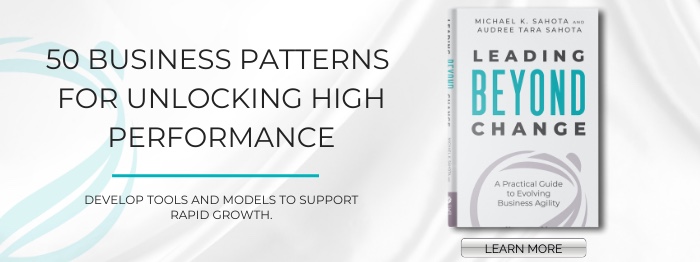Great leadership makes the difference between success and failure. It determines whether you’ll have passionate, engaged people in your workplace. A great leadership profile helps you zero in on the characteristics that are needed for leaders to unlock success. What makes a great leadership profile? It starts with Evolutionary Leadership.
Great Leadership is Evolutionary Leadership
A leadership profile is an identification of the characteristics that one wishes to see in a leader. A healthy leadership profile also identifies a path for growth. At SHIFT314, we’ve coined the term Evolutionary Leadership to capture the qualities and characteristics needed to lead an evolutionary journey toward high performance.

We’ve broken Evolutionary Leadership into four different key areas:
- Outcome Focus
- Self Leadership
- Developing Leaders
- Self Evolution
Why these four aspects? There are many different aspects of leadership that can be measured. Often, leadership profiles are focused on surface-level attributes. What we’ve done is identified the underlying leadership characteristics needed to create high performance. These four attributes are the most important elements that create long-term success.
A Leadership Profile is a Spectrum
Before exploring the dimensions of a leadership profile, it’s important to understand that it’s a spectrum. Each dimension is a linear scale representing how strongly a leader possesses that quality.

No one’s going to be perfect. People are going to have different places where they get stuck and attached to their own ideas. What we’re looking for is how effectively, routinely, and broadly a leader demonstrates these qualities.
The Evolutionary Leadership Profile
#1 Outcome Focus
- Willing to put aside their own ideas and agenda to benefit from other perspectives
- Focuses on shared outcomes
- Challenges themselves and others to create greatness
- Evolves the production capability of the organization
When a leader has a strong outcome focus, they’re able to see beyond their own perspective and their own agenda. They see other people’s perspectives and focus on the shared outcome. They’re not stuck in their narrow view and are able to consider the success of the whole organization. They consider, “How is this organization going to be successful over time?”

Evolutionary leaders balance short-term needs with building toward long-term success and growth. They also have a desire to create greatness and success for the company. They challenge themselves and others to focus on, “How do we work better? How do we work smarter? How do we create better outcomes for our organizational system?”
#2 Self Leadership
- Stays calm, focused and positive in challenging situations
- Comfortable with uncertainty
- “Walks the talk” to model desired organizational behaviors
- Comfortable taking risks (e.g. running experiments)
Self-leadership is about the ability to lead oneself. No one is fit to lead other people until they can lead themselves. It’s about, “Am I as a leader able to stay calm and focused, even in challenging situations? Am I able to move through uncertainty and complexity and be a calm, stable presence for others?”

Modeling these behaviors works to demonstrate the desired organizational behaviors for everyone. For example, being comfortable running experiments, trying out new things, and stepping into the unknown. Leaders who have mastery over themselves have mastery of their organizations. They help other people evolve by inspiring them.
#3 Developing Leaders
- Genuinely cares about people
- Creates space for others to contribute and lead
- Fosters the development of others, in preference to problem solving or solutioning
- People actively seek unsolicited advice and mentorship
The measure of success of a leader is their ability to create other leaders, not followers. We know we’re successful in creating other leaders when people step up and take responsibility. How do we do that? What are the characteristics we need to create engaged, motivated, and inspired people who are leaders themselves?

The first element is genuinely caring about people. From that place comes a very natural desire to create a space for others to contribute and lead. We don’t want to boss people around, so we create a space for their brilliance to shine.
As a leader, we’re focused on developing others. We’re not just about, “How do I get results right now?” We focus on, “I want to help people to be able to solve their own problems.”
Finally, the real test to see if someone’s really good at developing other leaders is that people will actively seek you out for advice and help. People who don’t report to us or are in other groups will reach out to say, “What’s your advice? What are your thoughts on this?” That’s how you know you’re doing a good job developing other leaders.
#4 Self Evolution
- Shares learnings from mistakes, errors, and failures
- Asks for help
- Takes full ownership of behavior, including making amends
- Committed to growing beyond their current limitations

The last element, self-evolution, is about measuring your rate of evolution as a leader. As a leader, when I’m evolving, I’m modeling that for others. Evolution is a transmission. As we collectively evolve, our organization will evolve. This is what gives an organization the ability to thrive.
When one is focused on their own self-evolution, they are focused on learning from their mistakes. They are ready to be vulnerable and ask other people to help, to learn and grow. Evolutionary Leaders take full ownership of their behavior, including making amends for things that they have done wrong. It sounds fluffy, but this is how leaders can model an evolved way of functioning. It’s how to build leaders at all levels. When we model our growth, other people can choose to grow.
The other aspect is that Evolutionary Leaders are committed to grow beyond their current limitations. Most organizations today are filled with leaders who say, “Yep, I’ve got it. I’m good enough.” But what is required for greatness is leaders who say, “I’m a work in progress and I want to get better.” This means moving beyond a Growth Mindset towards an Evolutionary Mindset. In this mindset, we are ready to evolve ourselves, not just learn about how to perform better in the external world. It’s an ongoing journey with no end.
Final Thoughts
Organizational survival depends on great leadership. Great leadership depends on having the right leadership profile. An Evolutionary Leadership profile will guide leaders to be incredibly successful as they evolve their leadership. It is an essential aspect for creating a high performance and a thriving organization.



